Few plants offer more abundant fragrance than the spring flowers of Daphne and its cousin Edgeworthia. These woody shrubs are both in the Thymelaceae plant family and are sure to brighten your garden with their beautiful blooms, just in time for warmer weather, walks in the garden, and fresh cut bouquets.
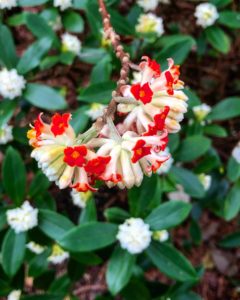
Both plants are deserving of more attention from gardeners in mild climates, where winter temperatures generally stay above 10F, though Daphne can grow in colder regions. They prefer to grow in part-shade with slightly acidic soil. However, they each have extremely specific soil requirements and are not well suited to be planted next to one another!
Daphne Details
Daphne odora just may be the most adored plant for its “fruit loop” fragrance in late winter and early spring. The scent is unmistakable, and it can cast a spell convincing you to fill your garden with as many specimens as you can find. But, beware, this is not the easiest plant to cultivate.
If you are one of the lucky gardeners who has a living, thriving specimen of Daphne, appreciate it! Never take for granted your success with this plant. For the rest of us, including myself, who cannot seem to keep this gorgeous plant alive, don’t feel bad. In general, Daphne is not long lived, usually lasting 5 to 10 years. They also do not react well to root disturbance and transplant badly. Additionally, Daphne odora is susceptible to virus infection, which causes leaf mottling. But most commonly, root rot is responsible for its demise. Specifically, Phytophthora, which is a fungus-like microorganism that survive as hyphae in the roots of diseased plants and in crop debris. It is easily spread in contaminated potting soil and by the splashing or flowing water, like heavy rain. The best way to deal with root tot is to control the amount of water and how it is applied to the plant.
That doesn’t mean you shouldn’t grow it, simply set your expectations appropriately, or grow it in a pot, like I do! Over the past 20 years living in zone 7 North Carolina, I have lost countless Daphne, but “hope springs eternal” and I tried again this year! Watch this video to get some expert tips. (742) Trying to grow Daphne, again – YouTube
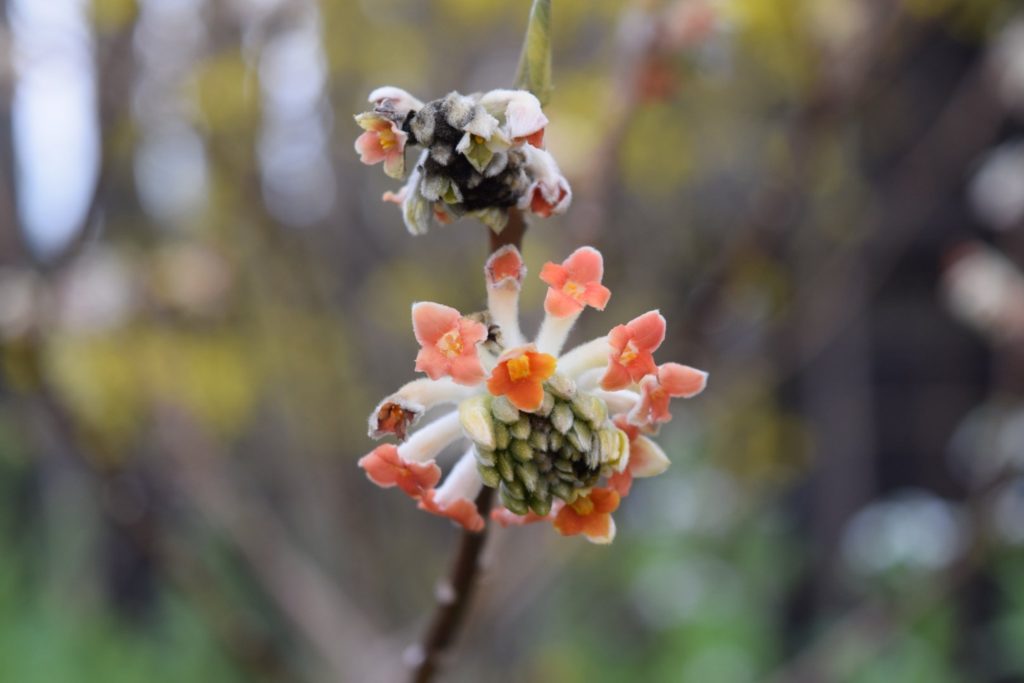
However, Daphne is ideal for growing in deciduous woodlands with a slope. They thrive in heavy soil when excess moisture drains away quickly. Ironically just a quarter mile away from my flat, boggy garden is a clay ridge, where gardeners have massive collections of Daphne that grow without any trouble at all. In the end it really does come down to “right plant, right place.”
There are a lot of different “types” of Daphne, in fact there are between 70 and 95 species of various deciduous and evergreen forms native to Asia, Europe, and North Africa. Interestingly, there are species that tolerate wet conditions better than D. odora. However, those are rare in the nursery trade and don’t match the fragrance offered by this species. There are many cultivars of Daphne odora to choose from, including brightly variegated selections. A few of my favorites include ‘Aureomarginata’, ‘Carol Mackie’, ‘Maejima’ and ‘Rebecca’. I also love the straight species with a solid green leaf with white flowers.

According to the “experts” Daphne odora grow best in fertile, slightly acidic, peaty, well-drained soils. For clarity’s sake, let’s break this down because that statement seems contradictory.
Fertile: This is a term that can easily be misconstrued. Technically fertile soil will contain all the major nutrients for basic plant nutrition, including nitrogen, phosphorus, and potassium. It should also have micronutrients like calcium, magnesium, sulfur, iron, and zinc. I recommend using a simple, organic fertilizer once in the spring to maintain proper fertility, such as Azomite.
Slightly acidic: Much of the US has slightly acidic soil, meaning pH levels lower than 7. Soil pH can be lowered by adding sulfur coated urea, or ground, aged pine bark, often sold as soil conditioner. If you do not know your soil pH have it tested before you start adding new elements. Here are some gardening supply companies that offer products that help adjust soil pH.
Peat: Peat based soil is like a sponge, therefore not exactly “well drained.” In my experience peat moss holds too much water, but here is the definition: “Peat is a type of soil made up of waterlogged, partially decomposed plant material including sphagnum moss and other acid-loving plants, which has built up over 10,000+ years in poorly-drained wetland habitats.” My advice is to skip the peat all together and instead incorporate leaves and other green organic matter into your soil to improve the texture and nutrient holding capacity, while increasing drainage.
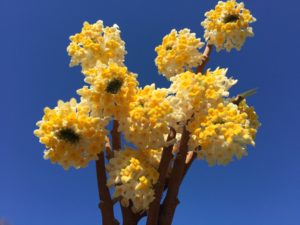
Well-drained: Yes, this is extremely important for Daphne! They really need well-drained soil. Again, I am not convinced that peat moss is the right decision. Instead, gravel may serve a better function for adding the drainage this plant really requires for surviving in the often-damp conditions of a home garden, especially on flat land.
Some of the happiest Daphne that I have witnessed have been in one of two places: under a large tree that is absorbing every drop of water, or near a street growing high and dry. But I think containers are a great opportunity to try Daphne because you can control the placement! In my case, I recently potted a Daphne that is placed on my front porch under the cover of the roof. That way it stays dry even in the heaviest of rainstorms.
Winter Daphne is a broad leaf evergreen that grows in full sun to partial shade. It is hardy in zones 5-9, maybe even into zone 4 in a protected location. Just remember, the key to success is drainage. Overall, Daphne requires very little maintenance. I would caution against heavy pruning. Instead, plant it in an area that can accommodate its overall ten-year size of 3’ x 3’, maybe a little bigger if you are lucky! Save any necessary pruning for the bloom season so you can enjoy the fragrance indoors in an arrangement.
Edgeworthia Elements
Native to Southwest China, Nepal, and Japan, the “paper bush” is a must have for gardeners in zones 7-9. The plant offers year-round interest but the fragrant yellow flowers in late Winter and early Spring truly set this apart!
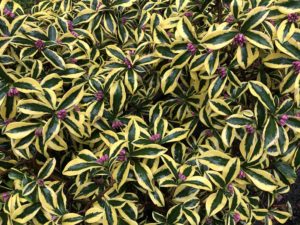
The common name “paperbush,” is a reference to its bark fibers which are used for making traditional Japanese paper called “mitsumata paper.” This durable paper has been used for centuries to make banknotes, so technically you are growing money when you include an Edgeworthia in your garden!
This deciduous shrub has tropical looking, dark green foliage through the summer. The leaves will turn pale yellow before falling off in late Autumn, revealing the silvery flower buds on the top of each shrub, providing ample Winter beauty.
The real show begins in mid-winter when the flower buds begin to open, showing the bright yellow blossoms that smell like honey! Over a period of weeks, they continue to expand into brilliant round balls filling the air with fragrance and keeping pollinators fully occupied. Watch these garden tours from my home garden to see how the flowers expand through the month of March here in central North Carolina Zone 7.
(742) Weekly garden tour – YouTube
(742) Weekly garden tour (try 2) 21 march 2021 – YouTube
There is a debate revolving around the species names, with some botanists lumping all varieties under the classification of E. chrysantha, while others prefer to divide the two most common types into E. chrysantha and E. papyrifera. Just from looking at the two types it would seem the difference in flower size and timing, as well as overall plant stature is distinguishing enough to consider them to be different. I recommend growing every variety that you can find because this is a fabulous plant! Currently I have six in my home garden.

Edgeworthia chryantha is the most popular species and can be found from online retailers. There are several different cultivars ranging in size. This is a much more vigorous plant compared to its cousin the Daphne, so allow it to have the space it needs to mature. Average ten-year size is about 8’x 8’ depending on the cultivar. A long-time favorite is “Snowcream” introduced by Plant Delights Nursery, which can grow to 12’x 12’, so plant accordingly!
Another noteworthy variety is “Akebono” sometimes sold as “Red Dragon.” This smaller statured plant can grow 5’x 5’ in ten years and has bright red, fragrant flowers. Unfortunately, this is rare in the trade and can be difficult to source.
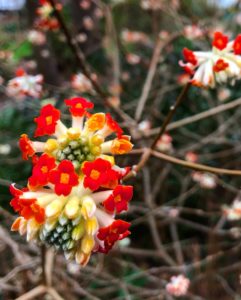
Though paperbush can be grown in full sun, I recommend part-shade to ensure it won’t burn in the hot summer sun. It also prefers, moist, rich soil, differentiating it from the dry tolerant daphne. I recommend adding plenty of organic matter to your soil to ensure your Edgeworthia will thrive year-round. And, be prepared to add supplemental water through the summer if the weather gets dry. This plant will wilt, alerting you that it needs a drink!
Overall, all these two fragrant shrubs are well worth including in your gardens for their fragrance alone. But both offer seasonal beauty through their foliage and structure and are relatively “deer resistant.”
Recommended Sources for Daphne and Edgeworthia

Recent Posts
- Smart Gardening: How Technology Is Revolutionizing Horticulture
- Understanding Gardening Zones: What You Need to Know
- The Right Tools For Your Gardening And Landscaping Needs
- Maximizing Your Harvest: Square Foot Gardening Chart for Beginners
- Holiday Garden Scents: Plants for Natural Aromatherapy in Your Home






